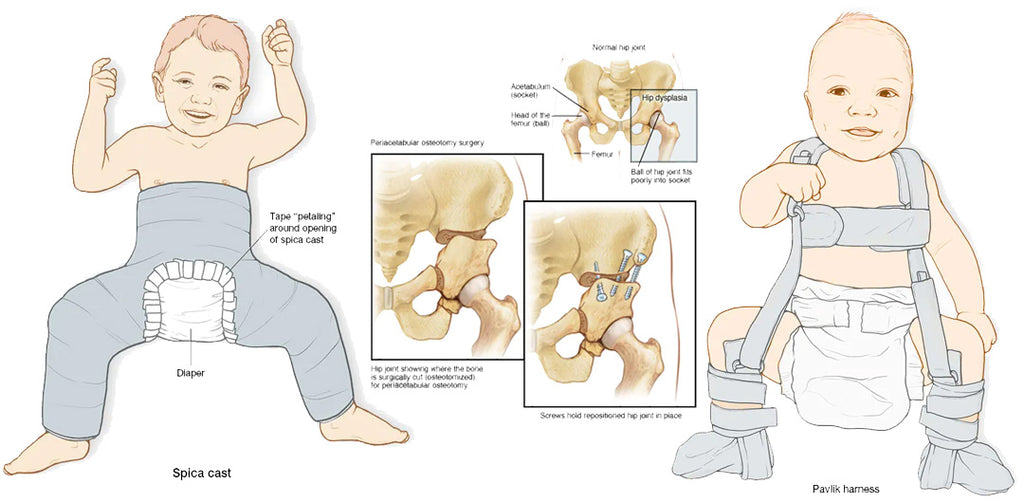
Hip Recovery Post-DDH Surgery: The Role of Braces and Therapy
Hip dysplasia
During well-baby visits, doctors typically check for hip dysplasia by moving an infant's legs into a variety of positions that help indicate whether the hip joint fits together well.
Mild cases of hip dysplasia can be difficult to diagnose and might not start causing problems until you're a young adult. If your doctor suspects hip dysplasia, he or she might suggest imaging tests, such as X-rays or magnetic resonance imaging (MRI).
Hip dysplasia treatment depends on the age of the affected person and the extent of the hip damage. Infants are usually treated with a soft brace, such as a Pavlik harness, that holds the ball portion of the joint firmly in its socket for several months. This helps the socket mold to the shape of the ball.
The brace doesn't work as well for babies older than 6 months. Instead, the doctor may move the bones into the proper position and then hold them there for several months with a full-body cast. Sometimes surgery is needed to fit the joint together properly.
If the dysplasia is more severe, the position of the hip socket can also be corrected. In a periacetabular (per-e-as-uh-TAB-yoo-lur) osteotomy, the socket is cut free from the pelvis and then repositioned so that it matches up better with the ball.
Hip replacement surgery might be an option for older people whose dysplasia has severely damaged their hips over time, resulting in debilitating arthritis.
Navigating DDH Surgery Recovery: A Timeline Guide
Recovery time after developmental dysplasia of the hip (DDH) surgery can vary depending on several factors, such as the specific type of surgery performed, the patient's age, overall health, and adherence to post-operative care instructions. Generally, recovery can be broken down into several phases:
Immediate Post-Operative Period (First Few Weeks): This phase often involves managing pain and swelling, with limited mobility. Patients typically use crutches or a walker.
Early Recovery Phase (1-3 Months): Mobility gradually increases during this period. Physical therapy is usually started to strengthen the hip and improve range of motion.
Mid-Recovery Phase (3-6 Months): Continued physical therapy and gradual return to more normal activities. Restrictions on certain movements and activities are often still in place.
Late Recovery Phase (6-12 Months): Most patients see significant improvements and may be able to return to most normal activities, including sports, although this depends on the individual case and doctor's recommendations.
Long-Term Recovery (1 Year and Beyond): Full recovery and maximum improvement in function can sometimes take up to a year or more.
It's important to follow the surgeon's and physical therapist's instructions closely to ensure the best possible recovery. Regular follow-up appointments will be necessary to monitor progress. Keep in mind that every individual's recovery journey is unique, and these timelines are approximate. For specific guidance related to your case, it's best to consult with your healthcare provider.
Enhancing DDH Recovery: Importance of Hip Braces Post-Surgery
This article delves into the recovery phases after DDH surgery, highlighting the crucial role of hip braces in ensuring successful healing and improved treatment outcomes.
The use of a hip brace post-surgery is a pivotal aspect of the recovery process for patients undergoing surgery for developmental dysplasia of the hip (DDH). The brace plays several key roles in recovery:
Stabilization and Support: After DDH surgery, the hip joint is in a delicate state of healing. A hip brace provides necessary support and stability, helping to maintain proper joint alignment during the initial healing phase.
Pain Management and Swelling Reduction: By limiting excessive movement, the brace can aid in reducing pain and controlling swelling, two common post-operative challenges.
Facilitating Correct Healing: The brace ensures that the hip heals in the correct position, which is crucial for long-term joint function and mobility.
Guiding Gradual Mobility Increase: In the early recovery phase (1-3 months), as mobility gradually increases, the brace can be adjusted to accommodate more movement while still providing support.
Aiding Physical Therapy: During physical therapy, the brace can be used to safely increase the range of motion exercises, contributing to strengthening the hip and improving overall function.
Preventing Post-Surgical Complications: The brace helps to prevent dislocation or improper healing of the hip, which are potential complications following DDH surgery.
In summary, a hip brace is not just an accessory but a crucial component of the post-surgical recovery process. Its importance in ensuring successful treatment outcomes and facilitating a smooth and effective healing journey cannot be overstated.
Absolutely, for specific guidance and recommendations regarding the use of a hip brace after DDH surgery, it is crucial for patients to consult with their surgeons and physical therapists. These healthcare professionals can provide personalized advice based on the individual's unique medical condition, type of surgery performed, and overall recovery goals.
The surgeon, who is familiar with the details of the surgery and the patient's medical history, can offer insights on how the brace should be used in the context of the patient's specific surgical procedure. They can advise on how long the brace should be worn each day, any adjustments needed over time, and when it might be appropriate to start reducing reliance on the brace.
Physical therapists play a key role in the recovery process as well. They can guide patients on how to correctly use the brace during various activities and physical therapy exercises. They can also monitor the patient's progress and adjust the brace usage as the patient's mobility improves, ensuring that the brace supports the healing process without impeding natural movement and strength development.
Regular follow-up appointments with these healthcare providers are important to monitor the patient's recovery progress and make any necessary adjustments to the treatment plan, including brace usage. This collaborative approach ensures that the patient receives comprehensive care tailored to their individual needs, promoting optimal recovery outcomes.
